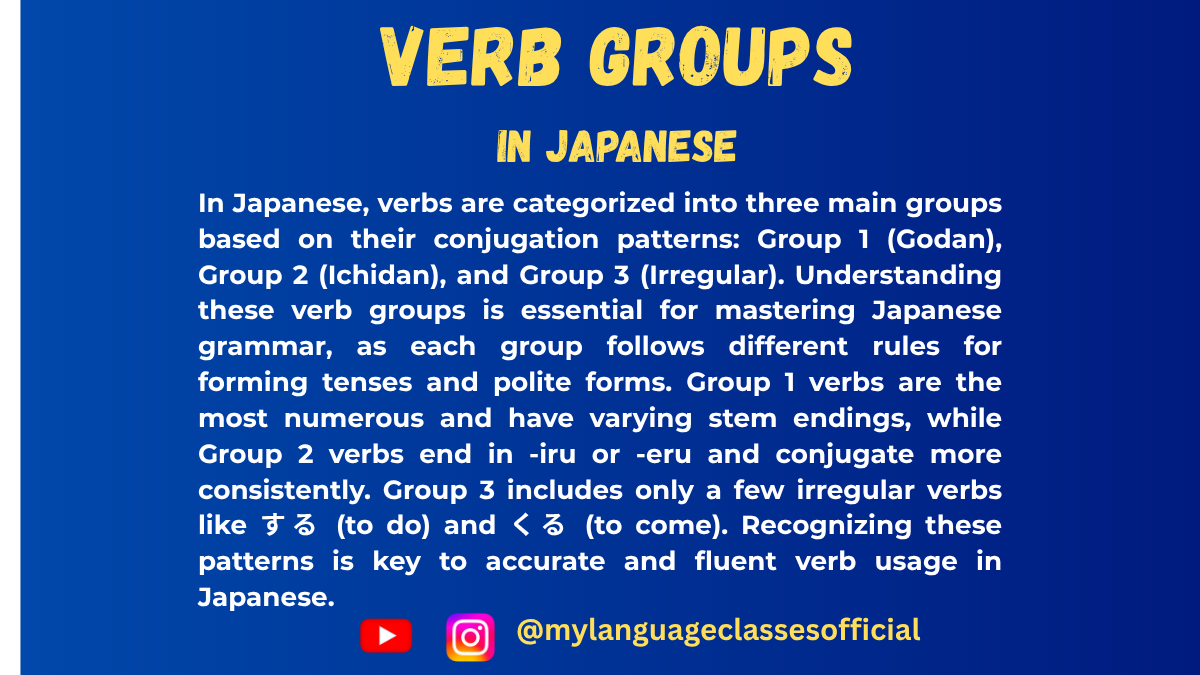Your cart is currently empty!
Japanese Verb Groups Explained: Godan, Ichidan and Irregular Verbs for Beginners

Understanding Japanese Verb Groups: A Beginner’s Guide
Learning how to categorize Japanese verbs is one of the first steps to mastering the language. Verbs are divided into three groups based on their conjugation patterns, making their usage systematic. Let’s explore these three groups—Godan verbs (Group 1), Ichidan verbs (Group 2), and Irregular verbs, with examples and exceptions.
Group 1: Godan Verbs (五段動詞, Godan-doushi)
Definition:
Godan verbs are named for their stem’s ability to “move” through five vowel sounds (あ, い, う, え, お) during conjugation. They always end with a consonant + “u” in their dictionary form.
Examples:
- 話す (hanasu) – to speak
- 飲む (nomu) – to drink
- 書く (kaku) – to write
- 待つ (matsu) – to wait
Conjugation Pattern:
- Dictionary Form: 飲む (nomu) – to drink
- Masu Form: 飲みます (nomimasu) – polite
- Negative Form (Casual): 飲まない (nomanai)
- Negative Form (Polite): 飲みません (nomimasen)
Exceptions in Group 1:
Some verbs appear to belong to Ichidan because they end with “iru” or “eru,” but they are actually Godan verbs. These include:
- 帰る (kaeru) – to return
- 入る (hairu) – to enter
- 走る (hashiru) – to run
Be cautious with such verbs to avoid misclassification.
Group 2: Ichidan Verbs (一段動詞, Ichidan-doushi)
Definition:
Ichidan verbs are simpler to conjugate than Godan verbs because their stems remain unchanged during conjugation. They typically end with “iru” or “eru.”
Examples:
- 食べる (taberu) – to eat
- 見る (miru) – to see
- 起きる (okiru) – to wake up
- 教える (oshieru) – to teach
Conjugation Pattern:
- Dictionary Form: 食べる (taberu) – to eat
- Masu Form: 食べます (tabemasu) – polite
- Negative Form (Casual): 食べない (tabenai)
- Negative Form (Polite): 食べません (tabemasen)
Exceptions in Group 2:
Most verbs ending in “iru” or “eru” are Ichidan, but some belong to Group 1 (Godan verbs). Examples include 帰る, 入る, and 走る. Be careful not to assume all “iru/eru” verbs are Ichidan.
Group 3: Irregular Verbs (不規則動詞, Fukisoku-doushi)
Definition:
There are only two irregular verbs in Japanese, and they do not follow the rules of Godan or Ichidan verbs. They are essential for daily communication, so mastering them early is a must.
1. する (suru) – to do
- Dictionary Form: する (suru)
- Masu Form: します (shimasu)
- Negative Form (Casual): しない (shinai)
- Negative Form (Polite): しません (shimasen)
Usage Example:
- 宿題をする。(Shukudai o suru.) – I will do homework.
- スポーツをします。(Supootsu o shimasu.) – I will play sports.
2. 来る (kuru) – to come
- Dictionary Form: 来る (kuru)
- Masu Form: 来ます (kimasu)
- Negative Form (Casual): 来ない (konai)
- Negative Form (Polite): 来ません (kimasen)
Usage Example:
- 友達が来る。(Tomodachi ga kuru.) – My friend will come.
- 明日来ます。(Ashita kimasu.) – I will come tomorrow.
Summary Table
| Group | Ending | Examples | Key Exceptions |
|---|---|---|---|
| Group 1 (Godan) | Consonant + “u” | 話す, 飲む, 書く, 待つ | 帰る, 入る, 走る |
| Group 2 (Ichidan) | “iru” or “eru” | 食べる, 見る, 起きる | N/A (except those in Godan) |
| Group 3 (Irregular) | N/A | する, 来る | None |
Tips for Remembering Verb Groups
- Practice Conjugation: Repeat conjugation patterns until they become second nature.
- Watch for Exceptions: Memorize verbs like 帰る and 入る, which may trick beginners.
- Learn Common Irregular Verbs: Start with する and 来る since they are widely used.
Understanding and categorizing Japanese verbs correctly is the first step to fluency. With consistent practice, you’ll soon find it easier to conjugate and use these verbs in conversation.
がんばってね! (Ganbatte ne!) – Good luck!
If you enjoyed this lesson, be sure to check out more posts like this on my blog at My Language Classes. Don’t forget to subscribe my YouTube channel and follow me on Instagram for the latest language learning tips and lessons. Leave a comment below to share your thoughts, or ask any questions you have about nouns.
Happy learning! 😊
📚 Continue Learning Japanese
Vikas Kumar is a dedicated language educator, content creator, and digital entrepreneur, best known as the co-founder of My Language Classes and The Curious Mind. With a strong focus on helping learners achieve fluency in English, Spanish, and Japanese, he has guided audiences worldwide through a diverse range of resources, including in-depth blog articles, engaging YouTube tutorials, and comprehensive Books.
Through My Language Classes, Vikas has built a thriving multilingual learning platform that serves students, travelers, and professionals eager to master communication skills for personal, academic, and professional success. His expertise extends to exam preparation for internationally recognized certifications such as JLPT, DELE, IELTS, and TOEFL, enabling learners to achieve tangible, career-enhancing results.
As the founder of The Curious Mind, he also explores broader areas of knowledge, including self-help, motivation, modern learning strategies, and thought-provoking insights on life and personal growth. His work blends practical teaching methods with a deep understanding of learner psychology, making complex concepts accessible and engaging.
Driven by a mission to make high-quality education accessible to all, Vikas continues to expand his reach across multiple platforms, including YouTube, blogs, eBooks, and social media communities, inspiring thousands to learn, grow, and embrace lifelong learning.


Leave a Reply